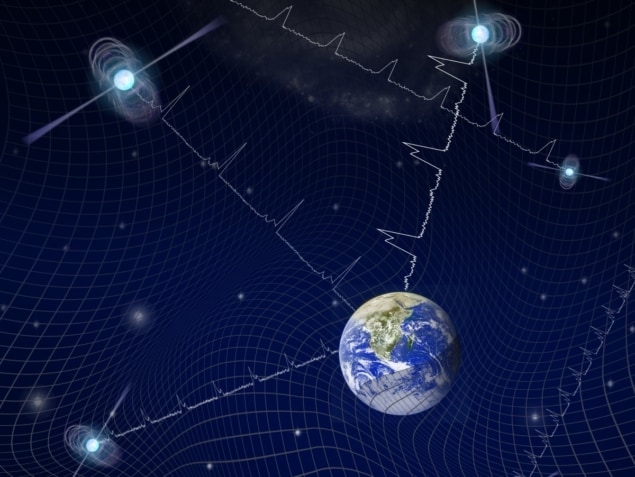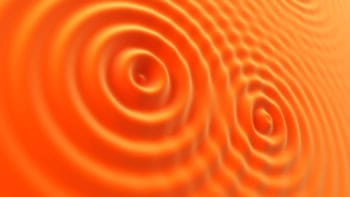
The observation of tiny deviations in the arrival times of radio pulses from neutron stars could be our first glimpse at gravitational waves from merging supermassive black holes – according to astronomers working on the NANOGrav pulsar timing array. The team has scoured 12.5 years of data from two radio telescopes for evidence of gravitational waves created by the mergers of large numbers of pairs of supermassive black holes throughout the history of the universe. Although this preliminary observation is far from conclusive, the astronomers are encouraged by the result and believe that the existence of a cosmic gravitational-wave background could soon be confirmed by observing more pulsars over longer periods of time.
Supermassive black holes are found at the centres of most galaxies – including the Milky Way – and have masses that are millions or even billions times that of the Sun. As galaxies evolve and merge, supermassive black holes can orbit each other and eventually merge – broadcasting gravitational waves. These mergers contribute to the cosmic gravitational-wave background, which is believed to be a noise-like cacophony of waves that permeates the universe.
Measuring this background would provide astronomers with a wealth of information about how galaxies form and evolve. However, the very low frequency gravitational waves from supermassive mergers cannot be detected with the existing LIGO–Virgo gravitational wave observatories.
Celestial clocks
Fortunately, millisecond pulsars offer a way of probing these gravitational waves. Pulsars are rapidly rotating neutron stars that beam pulses of radiation towards Earth. Their pulse frequencies are extremely stable – indeed, they act as “celestial clocks” with stabilities that rival that of atomic clocks.
The NANOGrav pulsar timing array monitors signals from 45 different pulsars in different locations in the sky. If a gravitational wave travels between Earth and a pulsar (or vice versa), the distance between us and the pulsar will expand and contract slightly. Pulses travel at the speed of light, so during the contraction pulses will arrive on Earth sooner than expected, whereas during the expansion pulses will arrive later.
This arrival-time deviation is dependent upon the angle between the direction to the pulsar and the direction of travel of the gravitational wave. So, a comparison of arrival times from an array of different pulsars should reveal the effect of gravitational waves. Measuring this effect, however, is very difficult because the deviations are on the order of a few hundred nanoseconds and occur over timescales of years.
On the curve
A powerful way of searching for this effect is to measure correlations between the arrival times of pulses from pairs of pulsars. When plotted as a function of the angle between the pulsars, the result is the “Hellings–Downs curve”. This curve is independent of the direction of the gravitational waves so it can be used to look for evidence for the cosmic gravitational-wave background – which should include waves travelling in all directions.
Radio signals from the 45 pulsars were observed for 12.5 years using the Arecibo Observatory in Puerto Rico (which has since shutdown) and the Green Bank Telescope in West Virginia. After doing an extensive statistical analysis of the data, the NANOGrav team found tantalizing preliminary evidence something is affecting the arrival times from different pulsars.
“These enticing first hints of a gravitational-wave background suggest that supermassive black holes likely do merge and that we are bobbing in a sea of gravitational waves rippling from supermassive black hole mergers in galaxies across the universe,” says NANOGrav member Julie Comerford at the University of Colorado Boulder.

Hunting gravitational waves using pulsars
However, the team is not yet able to conclude that the observed effect is the result of the cosmic gravitational-wave background. In particular, the team was unable to establish correlations between pairs of pulsars.
“We’ve found a strong signal in our dataset, but we can’t say yet that this is the gravitational wave background,” says NANOGrav’s Joseph Simon, who is also in at Boulder.
Scott Ransom at the US’s National Radio Astronomy Observatory adds, “Trying to detect gravitational waves with a pulsar timing array requires patience. We’re currently analyzing over a dozen years of data, but a definitive detection will likely take a couple more. It’s great that these new results are exactly what we would expect to see as we creep closer to a detection.”
The research is described in The Astrophysical Journal Letters.



